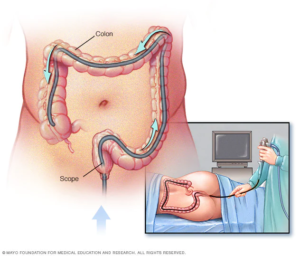Colonoscopy Phoenix is a robotic exam of your large intestine. It can help your doctor find and treat problems such as polyps or cancer.
You will need to follow a special diet f,or the day before your test. This usually means liquids only (water, Gatorade, tea, and coffee without milk or cream) with some restrictions.

A colonoscopy is an exam that lets your doctor look at the lining of your large intestine (colon). Your doctor may recommend this test to find out the cause of symptoms like blood in your stool or pain in your abdomen. It may also be used to check if polyps you’ve had are precancerous or cancerous and to treat any precancerous areas found.
The procedure is performed at a hospital, medical office, or outpatient center. It usually takes about 20 minutes. You lie on an examination table. Your doctor inserts a flexible tube with a camera on the end (called a colonoscope) into your anus and up into your rectum and colon. The camera sends video images to a monitor so your doctor can see. Your doctor can also use the colonoscope to remove polyps or take a small sample of tissue for laboratory testing.
Depending on how much sedation you receive, you may feel some pressure as the doctor inserts and removes the colonoscope, or when air or carbon dioxide is passed into your bowel to inflate it for better viewing. You may also have temporary wind pain or flatulence. These are not serious, but they can be uncomfortable.
Your doctor will probably recommend minimal or light sedation for you before your colonoscopy. This is because many people have a hard time breathing through their nose or mouth while under general anesthesia. Your gastroenterologist will ask you about your health history and medications before recommending the level of sedation for you.
The sedation your gastroenterologist gives you during a colonoscopy will depend on your age and your other medical conditions. For example, you shouldn’t have deep sedation if you have heart or lung problems. You may be able to drive yourself home after the procedure if you choose not to have sedation. If you do choose sedation, your gastroenterologist will place an intravenous line in one of your veins so the medication can be delivered quickly and safely. You will also be attached to equipment that monitors your heart rate, blood pressure, and oxygen levels during the colonoscopy.
Preparation for a colonoscopy
A colonoscopy is a screening test for gastrointestinal issues, like polyps or cancer. Before your procedure, you’ll need to clean out (empty) your colon, so your doctor can get a clear view of the large intestine. You’ll be given bowel preparation medications that will help this happen. These can be in pill or liquid form. The liquid option may be flavored or mixed with other liquids, such as sports drinks, to make it easier to swallow. Your doctor will provide you with specific instructions on how to take the medication before your appointment.
To prepare for your colonoscopy, you should follow a low-residue diet for the week before the exam. This means that you should eat mostly foods that are easy to pass, such as clear broth or bouillon, black coffee and tea, white bread, popsicles, plain yogurt, light juice and some types of frozen fruit. You should also start drinking a lot of water.
The day before your procedure, you’ll need to stop eating all foods and drink only clear liquids. The liquids should be mostly water, but you can add in some clear beverages, such as flavored tea or coffee and sports drinks. You should also start drinking a laxative the day before your procedure, which can be in pill or liquid form. The laxative will cause you to have a bowel movement. This is okay, but you should try to not have a hard bowel movement because it can lead to complications.
You’ll need to arrange for someone to drive you to and from the hospital after the procedure, since you will be given sedation for it. Make sure you have this person arranged before the day of the colonoscopy.
On the day of your test, you’ll arrive at the hospital and change into a gown. You’ll need to bring your insurance card and ID with you for the test, along with any paperwork that’s been provided by your primary care physician. You’ll then sit on a recliner or chair while the nurse inserts a catheter into your arm. The nurse will inject relaxing medicines into the catheter to keep you calm and comfortable while the doctor examines your colon.
During a colonoscopy
A person having a colonoscopy is usually given anesthesia or a sedative to prevent discomfort. They will be asked to lie down on an examination table and wear a hospital gown. Once the person is comfortable, a gastroenterologist will insert the coloscope into the back passage (rectum). Sometimes carbon dioxide or air is inserted into the bowel to help with the examination and make it easier for the doctor to see the bowel lining. During the procedure, the doctor may take a biopsy or remove polyps. Polyps are growths in the bowel that can be cancerous.
When the doctor is finished, they will take out the coloscope. The person will be offered something to drink and may go home about an hour after they are fully awake. The individual should arrange for someone to drive them home since they will still be under the effects of sedation.
People having a colonoscopy will have some pain or cramping in their stomach after the test. This is due to the gas or carbon dioxide in their bowel and should go away after a few hours. They may also have some bleeding after the procedure if a biopsy or polyp was removed. This is usually a small amount and can be stopped with clips or other methods. Very rarely, there could be a tear in the colon wall (perforation). This is a medical emergency and needs to be treated right away.
It is important to monitor yourself for side effects after the procedure. For example, if there is a lot of bleeding in the stool or your colon seems to be a different color, call your gastroenterologist right away. It is also important to keep an eye on the date of your next bowel movement. If it is too early, this can be a sign of bleeding in the colon. Bleeding after a colonoscopy is uncommon, but it is important to watch for it and contact your gastroenterologist right away if you experience it. They can recommend treatments and medications to stop the bleeding. In some cases, if the bleeding is severe or continues for a long time after the procedure, it might require a blood transfusion or other treatment.
Post-colonoscopy care
A colonoscopy can be a scary experience, but it’s the best way to screen for colorectal cancer. People at average risk should start getting them at age 45. The good news is that most people feel back to normal right away and the procedure only takes a few hours, once you factor in prep and recovery time.
You’ll lie on a table while the doctor inserts a thin, tube-like instrument called a colonoscope through your anus and into your colon and rectum. This tube has a camera that sends images to a monitor. The doctor can then look at the lining of your colon and rectum and, if necessary, remove polyps and other abnormal tissue. You will likely be under sedation for the procedure, so you won’t feel any discomfort or pain.
When the procedure is over, you will be moved to a recovery area, where nurses will keep an eye on your vital signs as you wake up from the sedation. Once you’re able to stand, you can leave the recovery room and return home. You should have someone drive you home because you will still be recovering from the sedation.
Once at home, it’s important to follow your doctor’s instructions about eating and drinking. Most doctors will tell you to eat soft, low-fiber foods and drink lots of fluids, such as water and low-sugar drinks with electrolytes. This is to replace the fluids you lose during the bowel prep for your colonoscopy.
Most people resume their normal diet after 24 hours. Some patients will need to eat a restricted diet for longer. You should also continue to take the laxative you were given, unless told not to by your doctor.
Your gastroenterologist will give you a list of foods to avoid and the date when you can safely begin introducing new foods again. It’s also important to talk to your gastroenterologist about your medications, especially if you take aspirin or other drugs that thin the blood; heart medicines such as clopidogrel (Plavix); or the newer anticoagulants such as dabigatran (Pradaxa) and rivaroxaban (Xarelto). These may need to be adjusted before your colonoscopy.







